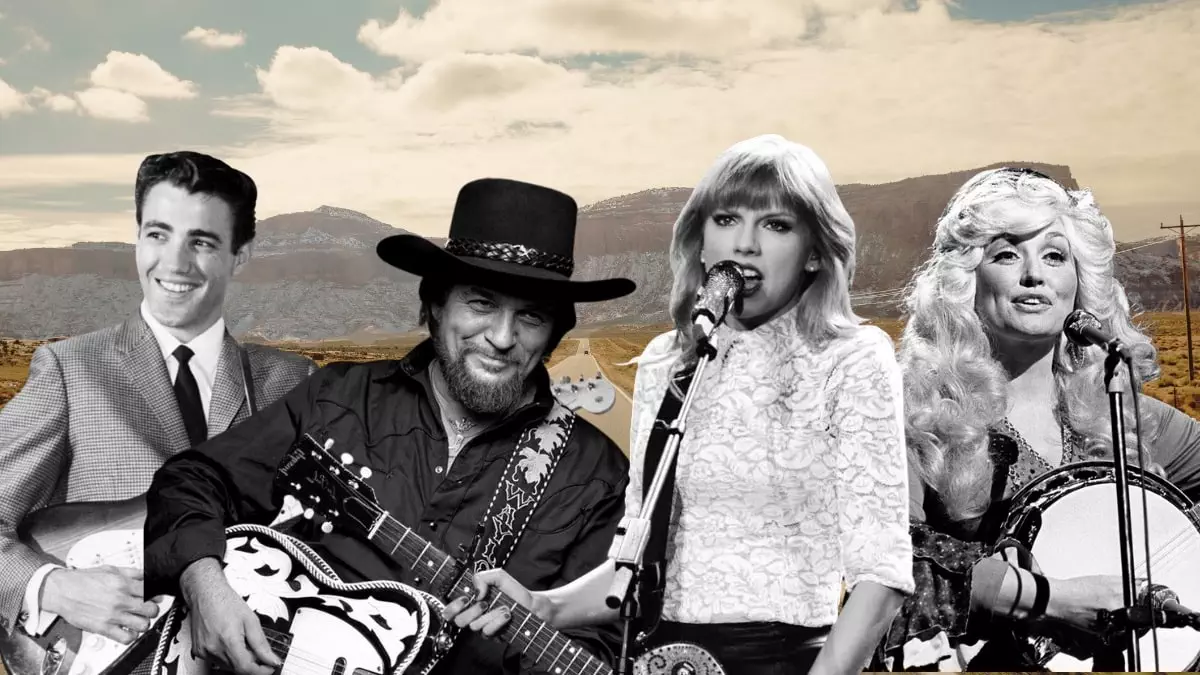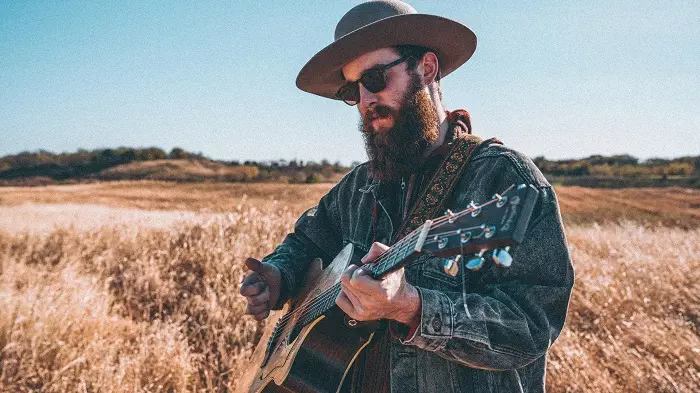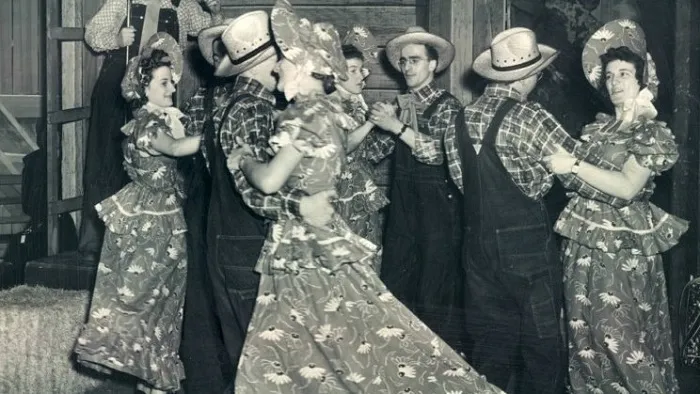Country music is one of the most popular American genres. In fact, more than 1.037 trillion Country songs were streamed on audio and video platforms combined in the US in 2020.
Born from a cultural melting pot, Country music is among the first genres of Modern American music. It arose and grew out of the music brought to the Southern United States by European settlers’ traditional ballads and African American Blues.
The Country music genre started out in the 1920s, with its stringed instruments and lilting vocals. Then, with every passing generation and new influences, it has continued to grow and develop into the many genres and subgenres that we know.
In this article, we’ll take you through the origins and six generations of Country music.
Country Music in a Nutshell
Country music started out as a union between the immigrants’ Folk songs moving to the United States. However, it became an official genre in the early 1920s, thanks to Fiddlin’ John Carson, Jimmie Rodgers, and the Carter Family.
From then on, Country music has continued to evolve, depending on what’s becoming popular – while still retaining the elements that make a Country song, such as narrative lyrics and stringed instrumentation.
Origins of Country Music
The birth of Country music as a genre can be traced back to the early 1920s, with the first commercially recorded song released in 1923. It was referred to as “Hillbilly” music, in preference to the settlers in the Appalachian Mountains from whom this style of music originated.
During the 19th century – as the country headed towards a modernized and industrialized lifestyle – the British Isles settlers and African Americans moved to the southeastern states. They took their traditions away from the isolated Appalachian Mountains and incorporated them into their new lifestyles.
These two diverse backgrounds continued to influence each other, ultimately meeting right in the middle and creating what we now know as Old-Time music – the first generation of Country music.
There are two primary instruments that distinguished Country music from other genres when it first started out: The fiddle and the banjo. Both are stringed instruments that came from two completely different cultures and traditions.
The Fiddle
The roots of Country music can date as far back as the 17th century. This is because the instrument that played an integral part in the creation of Country music is the fiddle.
This stringed instrument was carried over from the old European world to the North American continent. It was widely prevalent in white settlements, being the only musical instrument that they played.
The British Isles settlers played the fiddle, preserving many of their tunes and Folk songs for a long time. The fiddle was Europe’s contribution to early Country music. However, by the 19th century, the fiddling scene wasn’t entirely dominated by white people anymore.
Even though it started out as African-American fiddling, many black composers, as well as Native Americans and Mexican Americans, arose on the scene with great prominence. They even further developed their own fiddling styles, gaining popularity in cities like New Orleans.
The Banjo
In addition to the fiddle, the banjo is one of the most iconic instruments in American Roots music. This instrument carried the folklore and folktales of people of African descent to America.
By the 18th century, a fusion of sorts started to appear, with white settlers in the Appalachians adopting the banjo into their Folk songs. Bands were seen playing both the fiddle and the banjo together, culminating in the development of Country music and other genres.
The banjo started out as a four-stringed instrument from West Africa. However, during the 1900s, when people of European descent took an interest in it, the banjo was given a modernized look and became a five-stringed instrument.
History of Country Music
Starting from the 1920s, Country music has undergone many developments. And with each monumental change, a new generation was born. Country music has six generations, the last of which is the one we’re currently in.
First Generation – Old-Time Music
There is no way to pinpoint a certain time when Country music was born. We do, however, know when the first commercially-recorded Country song was released by OKeh records in June 1923.
Fiddlin’ John Carson’s “The Little Old Log Cabin” became a hit and marked the beginning of the earliest form of Country music, Old-Time music.
During the early 1920s, this style of music followed traditional Folk tunes and ballads, as well as church music, while the addition of the banjo highlighted the African-American Blues influences.
First Generation – Most Influential
We can’t talk about the first generation of Country music without mentioning two of the most influential acts in the genre: Jimmie Rodgers and the Carter Family. Both these acts are considered key contributors to Country music’s mainstream success.
Jimmie Rodgers
Combining “Hillbilly” music with yodeling might sound like a strange mixture. Nevertheless, it’s this peculiar style that distinguished Jimmie Rodgers from other acts.
Rodger’s songs were a mixture of the influences and teachings that he gained from African Americans on the railroads. Rodgers combined the Blues style of guitar-playing and Old-Time music with his yodeling technique, creating a musical style unique to him.
Rodgers rose to fame after recording the national hit “Blue Yodel No.1 (T for Texas)” that sold about 500,000 copies in 1927. Within six months, Rodger was gaining $2,000 worth of royalties per month. In addition, his discs sold somewhere around 3-4 million copies.
The Carter Family
The Carter Family consisted of the vocalist A. P. Carter, his wife Sarah on the autoharp, and her sister on guitar.
They were so successful that they had a global audience. And by the early 1930s, they sold over 100,000 copies of “Wildwood Flower.” They had many songs that topped the chart and became one of the two most iconic stars of early Country music.
Second Generation – Radio During the Great Depression
The second generation of Country music emerged in the 1930s and 1940s. It found itself in the eye of the Great Depression, which caused a steep decline in record sales.
However, this economic crisis ended up boosting Country music nationally. As radio steadily gained popularity as a source of entertainment, radio stations started playing live shows of traditional Appalachian music, known as Barn Dance.
The Effect of Radio on Country Music’s Popularity
These shows started with Atlanta’s WSB Saturday broadcasts, and soon rose to popularity in other cities, such as Philadelphia and Cincinnati. They even gained traction in Ontario, a Canadian province.
It wasn’t until 1993 when NBC started to air the National Barn Dance that Country music gained nationwide popularity. At that point, Country music was no longer strictly music listened to by rural Americans.
Then there was the “Grand Ole Opry,” one of the most popular live shows that played Country music. It was broadcasted from Nashville, Tennessee – the capital of Country music.
Grand Ole Opry often played Old-Time music along with another emerging music style, Western music. This style was closely related to lovelorn cowboys and gunfights, gaining popularity as a better-suited image of Country music – as opposed to the “Hillbilly” image.
From “Hillbilly” music to “Country and Western music,” this genre was beginning to spread its wings beyond reach. It was able to transcend socioeconomic boundaries, for barn dances were a common phenomenon, even in the highest of classes. There were barn dances in the Hamptons, in Palm Beach, and even in Westchester County, one of the wealthiest places.
It’s safe to say that the second generation saw Country music dusting off its boots because it continued to receive boost after boost.
Border Stations and Jukeboxes
The radio stations that were built by American businessmen along the borders to evade regulations spread Country music even further. These border stations would invite Country musicians and pay them well to play music and sell products.
These stations established Country music as a part of many Americans’ lives.
Moreover, with jukeboxes becoming widely available at diners and bars, more and more people were introduced to this genre, further cementing it into Americans’ daily lives.
Rock ‘n’ Roll
Country music faced a wall during the 1940s, Rock ‘n’ Roll was taking America by storm. This contributed to the development of “Honky Tonk,” a Rock-influenced subgenre of Country music.
Although this style would influence later generations of Rock ‘n’ Roll and Country artists, it wasn’t met with enough applause to overcome Rock ‘n’ Roll’s increasing popularity.
Third Generation – Post World War II and Rockabilly
During the 1950s and 1960s, Country music was still growing and branching out in many directions.
Western-Music Influenced
Country music in the early 1950s was steadily gaining influence from Western music. Artists like Al Hurricane, Little Joe, and Marty Robbins are among the stars who rose to fame at the time.
Nevertheless, following World War II, Western music’s influence wasn’t just stylistic. The political division among Americans was at an all-time high. This fueled the tension between Country music and Folk music artists and fans.
It was evident that no matter how similar their origins and styles are, neither genres were willing to associate with the other.
While Country music was known for its more conservative following, the artists, as well as fans of Folk music, were guided by more progressive ideas. Folk revival didn’t stand a chance against Country music, and ultimately ebbed away.
Rockabilly
Rockabilly arose as a result of the growing popularity of Rock-influenced Country music. It’s one of the earliest forms of Rock ‘n’ Roll, and it began with the Comets’ “Crazy Man, Crazy” and “Rock Around the Clock” success.
This is the generation that gave us Elvis Presley’s “Heartbreak Hotel” and Johnny Cash’s “I Walk the Line.”
Nashville Commercializes Country Music
Even though Rockabilly was a successful fusion of genres, many Country music artists thought that this style was excessively influenced by Rock ‘n’ Roll.
Thus, “a group of industry visionaries” founded the Country Music Association “in response to the burgeoning popularity of Elvis Presley.”
Executives and companies, like Columbia Records, decided that it was time to shift Country music to a more smooth and polished style.
This Nashville-style Country music was so rooted in commercialization that the Country music industry turned into a multimillion-dollar industry. The songs were Pop-oriented with Jazz instrumentation and smooth vocals.
Although it was met with huge success, it had its critics. Traditional Country music fans found this style to be too mainstream and lacking in artistic range.
Fourth Generation – Branching Out and the Birth of Outlaw Country
During the 1970s and 1980s, Country music branched out into different directions. Each direction established itself among the audiences, which made Country music all the more popular.
Country Pop
Country Pop is a blend of Folk music, the Countrypolitan sound, and Soft Rock. This subgenre emerged in the 1960s and gained popularity for its narrative lyrics and Country cadence mixed with catchy Pop tunes.
Artists like John Denver and Glen Campbell rose to fame, with hit songs topping the Country charts. Dolly Parton, probably the most popular name that emerged from this genre, crossed over to Pop music and has been leading an immensely successful career to this day.
Even though Country Pop was doing well on charts, it still had its critics. In 1974, traditional Country music artists formed the Association of Country Entertainers, but ended up disbanding almost right away.
Outlaw Country
A misnomer, Outlaw Country represented a group of artists’ desire to part from the dominant sound of Nashville’s record companies. Waylon Jennings and Willie Nelson were at the forefront of this genre, winning recording rights to create music unique to them.
Outlaw Country gained inspiration from Rockabilly and Honky Tonk. It combined these subgenres with Country instrumentation. In addition, the artists wrote their own lyrics, so many of the songs that came out then were heavily introspective.
Country Rock
Country Rock arose as a result of the British Invasion‘s aftermath and a general aversion to mainstream Country music.
This style of music started out with an impressive list of acts: Bob Dylan, The Eagles, and even The Rolling Stones joined the genre with their song “Dead Flowers.” These artists, among many others in this genre, continue to influence both Rock and Country music.
Fifth Generation – Expansion into the Mainstream
With Rock music becoming Alternative and FM radio expanding, Country music, as usual, seized the opportunity to reach a larger audience – specifically, a global audience. Moreover, female artists carved out a niche for themselves in the genre.
Garth Brooks
Country music owes its global success to Garth Brooks. In the 1990s, he broke sales and concerts attendance records, becoming one of the most successful artists in music history.
In fact, Garth Brooks’ hit song ‘The Dance’ became the number one streamed Country song of all time on Apple Music. He was followed by artists like Tim McGraw and Clint Black.
Female Country Musicians
Among the bands, the Dixie Chicks were the most popular Country acts, with their debut album certified 12x platinum and their sophomore album 10x platinum.
Another female musician who achieved incredible success was Shania Twain. She became a global star with her sophomore album selling over 20 million copies and its follow-up selling over 40 million copies worldwide.
Sixth Generation – Embracing Diversity
Country music has continued to branch out into new genres since the 2000s and shows no signs of slowing down in its efforts to reach more ears.
Still influenced by Rock/Alternative music, many artists in the early 2000s like Bon Jovi and Kid Rock incorporated their Rock-based backgrounds into Country releases that became massive hits.
But even with the world turning more towards other genres, Country music somehow remains as relevant as ever – especially during the 2010-2020 decade. Country artists are either collaborating with Pop or R&B artists, or artists from other genres are releasing Country songs.
Integration of Country Music Into Pop Culture
Going through the six generations of Country music, we can see how this genre has been constantly lending itself to adapting to whatever is popular at the time. This proves just how versatile and inclusive of other genres it can be.
Despite the huge popularity of Country music across time, it still took some time to integrate into Pop culture. Nevertheless, in the past two decades, there are two female Country artists who’ve helped popularize Country music and introduce it to mainstream culture.
Carrie Underwood
After Country singer Carrie Underwood won the 2005 fourth season of American Idol, she went on to break every possible record for a Country music artist. She even broke her own Guinness Book record of having 14 No.1s.
She’s one of the all-time greatest artists of Country music, selling over 65 million records and winning seven Grammy Awards. She’s popularized Country music in such an unprecedented way that her name has already gone down in history.
Taylor Swift
It’s unbelievable how Taylor Swift was just 16 when she wrote and released her self-titled debut album in 2006. Swift’s album remained on the Billboard 200 for 275 weeks, which left this young girl’s print on Country music.
Taylor Swift proceeded to release hit albums one after the other. She won Album of the Year at the Grammy Awards when she was only 20, and she’s won the same award two more times. And as of now, she has 10 Grammys.
Artists like Carrie Underwood and Taylor Swift have reintroduced Country music to Pop culture, making it more accessible to the world than ever before.
What is Country Music: Conclusion
Country music’s story is one of constant evolution. From its humble beginnings to its global reach, the genre has thrived by embracing new influences while staying true to its roots.
Country music has a rich history, beginning in the 1920s, with European Folk tunes and African American Blues contributing to the evolution of the six generations of Country music we know today. Collaborations across genres are common, and Country music’s adaptability ensures its continued relevance.


















